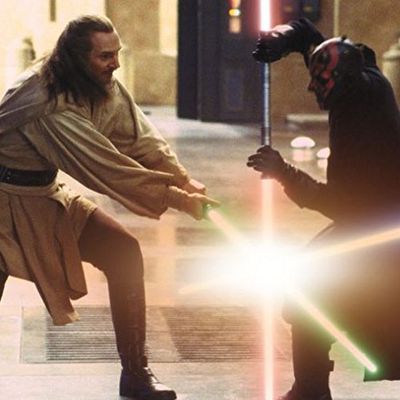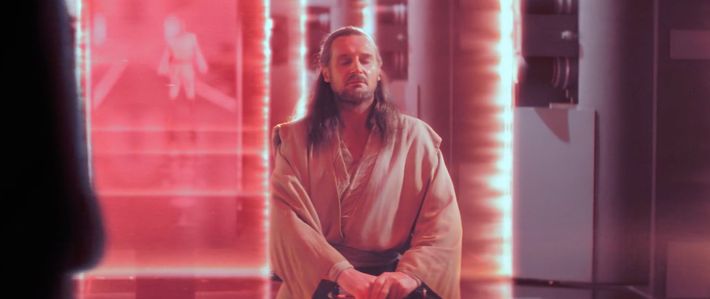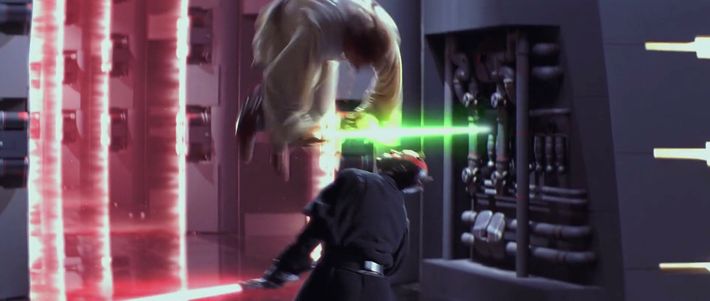

In the lead-up to Star Wars: The Last Jedi, we look back at the first Jedi (narratively speaking) with a series of stories about the much-beloved and never-disparaged prequel trilogy.
The Star Wars prequel trilogy was, for better or worse, driven by a single man’s vision. George Lucas came up with the story. He directed all three of the installments. He had final say in every aspect of the mythology, from tie-ins to toys. That said, when he was preparing what is perhaps the trilogy’s most iconic scene, the three-way lightsaber battle that acts as the climax of Star Wars: Episode I — The Phantom Menace, he had a problem that he couldn’t solve on his own.
“George has never been in a fight in his life,” says the trilogy’s stunt coordinator, Nick Gillard, his English drawl rising into a chuckle. “So he didn’t bother, really, writing it. It would say something like, ‘A vicious lightsaber battle ensues — seven minutes,’ and you could fill in the gap there.” Gillard pauses for a beat. “But that’s much better for me.”
Operating with that kind of carte blanche, Gillard acted as choreographer and trainer for the tussle, as well as de facto writer and director for much of it. The final product is intimately familiar for Star Wars nuts: While John Williams’s “Duel of the Fates” plays, noble Jedi ascetics Qui-Gon Jinn and Obi-Wan Kenobi go up against the sinister Sith lord Darth Maul, who wields a truly badass double-bladed lightsaber. The end result is seamless and smooth, but it was far from a cinch. In order to get to the finish line, Gillard had to invent an entirely new form of sword fighting, map out minute after minute of steps and swings, rehearse for three exhausting weeks (a full one-fifth of the total rehearsal time for all the movie’s stunts), and execute part of it in reverse. Gillard wanted to make a sequence unlike anything before seen in Star Wars. And he’s skeptical that we’ll ever see anything like it again.
Gillard was a veteran of the stunt world by the time he got the gig. Born in Brighton, he ran away from military school as a youngster and joined the circus, then started stunt work at age 18. He went on to work repeatedly with Lucas on Willow, Labyrinth, and the Indiana Jones films; and by the late 1990s, he was working on the TV series The Young Indiana Jones Chronicles. During that last job, he was asked to carry an envelope to producer Rick McCallum and stumbled across some extremely valuable information.
“It was an open envelope so, of course, I looked inside there,” he recalls with a laugh. To his shock, he found preliminary art for what would become The Phantom Menace. “I think it was the storyboards for the pod-race. This was very secret. Nobody knew that Star Wars was going to get done again. I’m looking at these storyboards and thinking, That looks like Star Wars.” He kept mum but soon afterward was asked to come aboard the nascent project. It was a tall order from the very beginning: “They said, ‘George wants you to come up with a new kind of martial art.’”
Sure, there had been lightsaber fights in the original trilogy, but only with the ancient Obi-Wan, the lumbering cyborg Darth Vader, and the barely trained newbie Luke Skywalker. All the other laser-sword-wielding Jedi had been exterminated by the forces of evil. By contrast, the prequels would be set in an earlier era, when the Jedi were prosperous and many. As Lucas would put it in a behind-the-scenes documentary, he wanted moviegoers to see “a Jedi in his prime, fighting in the prime of the Jedi.” He turned to Gillard. “I thought I wanted a faster version of what the other movies were; a more energetic version; and that’s basically what he gave me,” Lucas said.
The style may have looked to Lucas like a hyperspace rendition of the original trilogy’s fights, but Gillard says he didn’t actually base the prequels’ lightsaber style on them. Indeed, he ignored them almost entirely. Those old fights had been largely based on fencing, and though Gillard had enjoyed them as a younger man, he felt that they were somewhat stale as of the late 1990s. “The world had moved on since then, and that wasn’t going to work,” he says. “I just abandoned it and went my own way with it.”
Gillard and his staff created a synthesized method of swordplay that was entirely their own. It was “an amalgamation of all sword fighting,” as he puts it, that drew heavily from kendo, but also dipped into an array of other styles of movement, including rapier, samurai, and even tennis and tree-chopping. He wanted it all to be extremely fast, so it could be realistic — or as realistic as a lightsaber fight can be. “I thought, Okay, if they’re going to use swords against laser guns, they’re going to have to be very, very fast with them. This thing’s going to have to move all around, otherwise it’s going to start to look really stupid and unbelievable,” he says.
This new lightsaber approach would also have to demonstrate that everyone who used it had a lethal degree of expertise. He compares it to chess — at any given second, the fighters had to hold their opponents in a position of check, where there was only one way to escape: “They can only parry there, they can only attack there. The moves are so natural or so correct, that’s the only place they can be.”
Constructing a language is one thing; writing literature with it is another matter entirely, and Gillard didn’t have much time to put together his first presentation to Lucas. In Gillard’s recollection, he had “three days and a camera crew” to shoot some test footage and get Lucas’s buy-in. He recruited three stuntmen, including a relative unknown named Ray Park, whom he’d learned about thanks to a friend who had worked with Park on Mortal Kombat. Gillard fell in love with Park’s technique and hoped Lucas would not only go for the fighting style in the footage, but would also cast Park as Darth Maul. Lucas was, indeed, wowed by the test, and by Park. It was time for the fight to enter prime time.

A different kind of movie might have relied heavily on stunt doubles shot from a distance for the fight. Not so with Phantom Menace. Lucas was willing to use doubles sparingly, but mostly wanted his leads in on the action. “It would be not a very exciting sequence, I think, if it was all just done with doubles, because most of the emotion of the fight is on people’s faces,” Lucas said. That meant Gillard now had to teach his language to two students without formal training: Liam Neeson, who played Qui-Gon; and Ewan McGregor, who played Obi-Wan. In order to convey the choreography, he developed his own shorthand for the two superstars. “We developed a style of writing it like a script,” he recalls. “It looks like a kind of code form. You can write it down in letters. It might be ‘RS,’ which is right shoulder. Then you could write a fight in this kind of code and send it to them, and they would be able to read that and practice it on their own.” But for the most part, they were all training together, in person.
Park was a breeze, due to his existing experience in stunts, gymnastics, and martial arts. McGregor was an eager beaver with boundless energy, so he had an easy go of it, as well. Neeson, however, had a physical stumbling block. “Liam’s six-four, and Ewan and Ray Park are like five-nine,” Gillard says. “When you’re swinging, it’s such close quarters, particularly when they’re three of them who are fighting, and they’re having to cross over with these swords flying in every direction and Ray Park’s double-ended sword. That’s very difficult if you’re tall.” Nevertheless, they all gelled. So enthusiastic were they that they had to stop themselves from involuntarily making the bzzh-bzzh noises of the lightsabers with their mouths. After three weeks of rehearsing just that fight, Gillard and his trio of performers presented what they had to Lucas. He gave them the go-ahead and shooting began.
The fight comes as the forces of good are finally taking a swing at the sinister Trade Federation on the peace-loving planet of Naboo. In fact, four fights take place simultaneously: Young Anakin Skywalker charges his spaceship against the Federation mothership, the bumbling Gungans take on a droid army in an open field, and Queen Amidala and her guards go up against some other droids. But easily the most wonderful of these skirmishes is the one that begins with Maul appearing before Obi-Wan and Qui-Gon in a giant doorway that separates an ornate hangar from a massive, multilevel, metallic chamber with a giant tube of energy in its center. After moving into that chamber, Obi-Wan is knocked from one level down to another in an epic fall, for which McGregor’s double, Andreas Petrides, dropped from a height of 80 feet down to a 15-foot-high airbag. I point out that that sounds insane, but Gillard responds in deadpan: “No, it’s pretty standard. I’ve done 220 feet once.”

Getting Obi-Wan back up was even more of a challenge. After falling, he hangs from a ledge, and has to return to the action by lifting himself up. Traditional methods of that lift just looked off. “There was talk of doing it from a little trampoline, a trampette, but the problem with that is you have to go down before you go up,” Gillard says. Then, a decidedly low-tech solution occurred to him and Neeson stunt double Rob Inch: raising McGregor up by hand on a block of wood. “We just got a plank, a scaffold plank, and Ewan stood on it, and we squatted and we launched him from there. It made gravity seem more realistic. Sometimes, even on the biggest films, you do what might look really rubbish, but it works.”
Obi-Wan chases after Qui-Gon and Maul, but all three of them get separated from each other when they enter a hallway with impenetrable energy doors that open and close at intervals. It’s there that one of the coolest bits of the fight occurs — and it doesn’t involve any actual fighting. Qui-Gon, temporarily isolated, doesn’t stand at attention while waiting for the door to open. Instead, he falls to his knees, closes his eyes, and meditates while Maul paces around on the other side of the energy field.

According to Gillard, that was all Neeson. “It’s a tricky subject, but bollocks, the truth should come out,” he says. “The gates are closed, you’ve got however long it was, 20, 30 seconds to wait. He’s going to find something as an actor. What he found was he sat down and meditated.” Park’s physicality in that moment, on the other hand, came from Gillard: “Ray said, ‘I don’t know what to do. What do I do?’ I said to him, ‘When you see those tigers in the zoo and they’re just pacing up and down their cages all the time — why don’t you do that vibe?”
Mindfulness isn’t enough to save Qui-Gon, however. Once he and Maul are reunited, they clash while Obi-Wan once again gets trapped behind a door and watches helplessly. Maul fakes Qui-Gon out with a threatened hit to the head, then spins around and fatally stabs him through the chest. Gillard knew he had to make such a high-profile death interesting, so he subtly incorporated character differences into the lethal exchange. The fake out is called a feint in combat lingo, and it’s close enough to cheating that a noble swordsman wouldn’t deploy it. But for a Sith lord? “We wanted a trick in there,” Gillard recalls. “If you had two top swordsmen, they probably wouldn’t use a feint because it’s a little bit on the dark side.” Or the Dark Side, as the case may be.
As weighty as the death was, as innovative as the meditation was, and as high as the drop was, they were all easy compared to one of the final moves of the sequence: Obi-Wan gets knocked into a pit, where he hangs from a handhold before pulling himself back up onto the surface. It seems simple enough, but it was a minor nightmare to execute. They needed him to effectively fly backward, but couldn’t figure out how to get that effect. Then, they stumbled upon an idea: repurposing an air ram. Air rams are typically used to simulate explosions, but if you take away the fire and aim it sideways, it just pushes out a huge gust in a massive scissor action. Et voilà: a flying Jedi.

That still left them with the even bigger problem of getting Obi-Wan on his feet again. For the second time in the fight, he lifts himself up from a death drop, but this time, he somersaults and slashes Maul in half. The only way to get the somersault to look right was to actually shoot it backward, with Obi-Wan leaping toward the hole. That meant Park and McGregor’s doubles both had to do all their motions in reverse, making sure their clothes moved as little as possible and their steps were as aligned as they could be — otherwise, the reversed nature of the footage would be obvious.
As audiences can attest, they pulled it all off. When The Phantom Menace was released, even critics who were skeptical about the film as a whole were impressed by what Gillard had wrought. “In masterful pirouette, the Jedi Knights battle through the Wars series’ most intense, athletic and protracted choreography,” wrote L.A. Weekly’s Greg Burk. The Village Voice’s J. Hoberman said the ménage à trois “could have been choreographed for Errol Flynn.” Joe Holleman of the Saint Louis Post-Dispatch called the fight “as good or better than anything Lucas created in the original films.” Fans concurred, and two decades later, you’ll still hear them praise it, even as they damn the rest of the trilogy.
Gillard went on to choreograph episodes two and three, as well, but wasn’t asked back for the post-Disney-purchase sequels The Force Awakens or The Last Jedi. He’s polite about those newer films, but not exactly enthusiastic, merely offering me the diplomatic statement, “It’s always tough to watch your child become a teenager.” He thinks the whole Star Wars enterprise is being run differently now. Back then, they were almost like indie pictures, insofar as Lucas controlled every aspect of the production with nearly no studio input. “When you worked for Lucasfilm, it was family,” Gillard says of the old days. “When you work on a big studio-based picture, it just isn’t like that, because there are so many execs and so many people beyond the line producer and beyond the director that you don’t even know who they are. With Lucasfilm, it stopped at George, and there he was on the floor. If a decision needed to be made, bang, there it was.”
Overall, he just feels lucky that he got to be part of something so iconic. Right now he’s working on a film that’s shooting in Louisiana, and he says he recently had a reminder of the impact of his work. “I was walking down the street, and somebody said, ‘Nick Gillard,’” he says. “I went, ‘Oh, yeah, hi.’ I just think it’s somebody I must know. They’re like, ‘Oh my God, you did Star Wars.’ That’s what Star Wars is. It kind of trumps everything else that you do. It’s a blessing.”

